| Web
Crossing Webmail
Introduction
A
Webmail Tour
Webmail
FAQ
Troubleshooting
& Resources
Introduction
Web
Crossing 4.0
contains a complete industrial-strength SMTP mail
server providing
private email accounts for members, including mailing
lists, POP3
accounts, IMAP access and Webmail. Permissions and other basic
settings for these features are described on the Email
Services page. This section deals with Web Crossing Webmail
features and settings not covered in that section.
A
Webmail Tour
It
is easy to roam about Webmail and use the features
without referring
to documentation.
Let's
tour through the major Webmail features to give you an idea for
what is available - both to regular users and some
special settings
available just to the sysop.
For
the following examples, we will use a test site,
lifemind.com.
Joe User is an ordinary user at lifemind.com.
We will look
through his Webmail, and, as sysop, look at settings
which affect
his and other members' Webmail.
Figure
1 - Toolbar

Figure
1 shows the You Have Email button lit - indicating
that Webmail is waiting. If your current contact address (set
in Personal Preferences) is the same as your local Web Crossing
address then you will see this whenever new mail is waiting for
you. If, however, you are using an outside contact
email address
(you have set a forwarding address) then no new
Webmail will ever
arrive. However, you can still use Webmail to send
email.
Figure
2 - Webmail Top Level
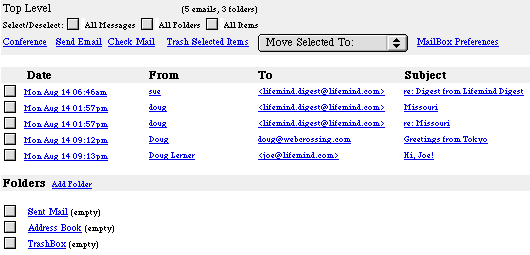
Upon
entering Webmail, as shown in Figure 2, you
can see messages
in the top-level folder, and a list of sub-folders.
New sub-folders
can be created to any level and folders and messages
can be freely
moved to any folder. Three folders are always present
in the Top
Level - Sent Mail, Address Book and the
Trashbox.
These folders may be also be moved - doing so creates new Sent
Mail, Address Book and Trashbox folders.
The
incoming mail message list shows both the From name and
also the To name. The To name is useful for users
with multiple email aliases and also for users with
just one email
address, so you can see at a glance if the email was directed
to you, or if you are a secondary recipient (such as a mailing
list recipient or perhaps a "CC" recipient
to somebody
else's email.
Clicking
on a message opens it up for reading.
Figure
3 - Reading Email
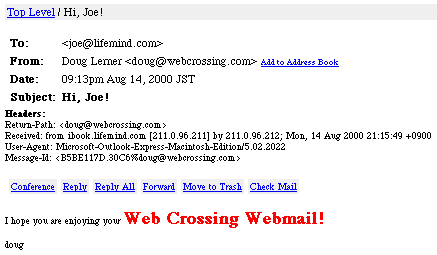
Figure
3 shows email being read. Note that the sender's name can
be added to the user's Address Book by just clicking on a link.
Optionally, received Internet headers are shown (this
can be turned
on and off in the user's Mailbox Preferences.) Web
Crossing Webmail
fully supports the receipt of HTML mail, as Figure
3 also
shows.
Before
replying to this email, let's see what happens when
the user adds
the sender's address to his Address Book.
Figure
4 - Address Book Confirmation

Figure
4 shows the confirmation of the Address Book entry that was
added, along with a link to the Address Book.
Let's
detour for just a minute into the Address Book. Then we will go
back and reply to the email we were reading.
Figure
5 - Address Book

Figure
5 shows the contents of the user's Address Book.
Address Book
entries can be modified and comments can be attached
to each entry.
If an entry contains comments, like Taro Watanabe does
in Figure 5, a Comments icon is shown. You can
store information
about each contact, such as personal information, other contact
information, etc., in a free form database by
clicking on an Address
Book entry.
Let's
return now to the mail we were reading and send a
reply.
Figure
6 - Replying to an Email
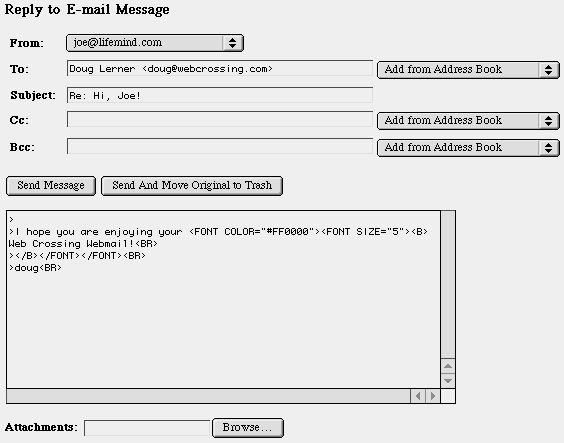
The
components of a reply message (and this also applies
to forwarded
messages) are:
Selection
of the From (outgoing) address.
This defaults to the recipient address if the recipient address
is one of the user's email aliases. If not, the From
address defaults
to the user's first email alias. When replying (or sending new
email, or forwarding email) the user can choose any registered
email alias as the outgoing (From) email address. In
this example,
the following addresses are selectable as outgoing
addresses:

joe_user@lifemind.com
is the default email address for this user.
Joe@lifemind.com
is an email alias. It is selected by default because the mail
was addressed to this address. info@hamuni.com
is another
email alias for this user (hamuni.com is a
domain supported
on this site). Finally note that this user can also send email
from the address joey@hotmail.com. This is obviously not
a domain supported by this site, but since this user
has a hotmail
account the sysop set this email alias for the user so the user
could conveniently send outgoing Webmail from that address when
necessary.
Selection
of the To, CC and BCC (recipient) addresses.
Email is pre-addressed to the sender (if Reply All had
been selected, the mail would also be pre-addressed
to the other
recipients of the email, taking care not to include duplicate
addresses.) Other addressees can be added via the Address Book
pop-up menus.
Message
Body .
The contents of the received email are pre-quoted for
convenience.
Attachments.
Binary attachments may be sent along with Webmail
(and received,
of course).
Send
Selection.
You can choose to just Send the message or
simultaneously
Send and Trash the Original, which is very
convenient for
avoiding clutter in your Webmail box. Sent Mail is
automatically
copied to the Sent Mail folder for later
reference.
After
sending the mail, let's look at the Top-Level once
again.
Figure
7 - Reply Indicator

Figure
7 shows the same message as before. There are two
things different
though: (1) the links are dimmed, which
indicates the message
has been read and (2) There is a Reply Indicator next to
the subject, which indicates that this message was replied to.
Clicking on the link helps you locate the reply. The
mail message
now contains a reference link to the reply, as shown
in Figure
8.
Figure
8 - Reply Link

Clicking
on the link takes you to the reply (unless the message has been
deleted). The reply itself also contains a reverse link back to
the original message, shown in Figure 9, which
helps keeping
track of your messages and replies easier. Reply
links and Original
links maintain their links even when messages are moved between
folders.
Figure
9 - Reverse link from reply to original message

Moving
on with the tour, you can add as many personal folders as you
want, and can create as many sub-folders you need to any depth.
Folders and messages can be moved freely between any
of your personal
folders.
Figure
10 - Personal Folders

Figure
10 shows some personal folders this user has
created. Enemies
is, fortunately, still empty. Friends contains
3 folders.
Pets contains 1 email and 2 folders. And
Relatives
contains 2 emails, at least one of which is unread,
which is why
it is red-flagged.
Items
can be selected and Trashed (moved to the TrashBox
for later deletion)
or moved to personal folders in one step, via a popup
menu.
Figure
11 - Moving Items
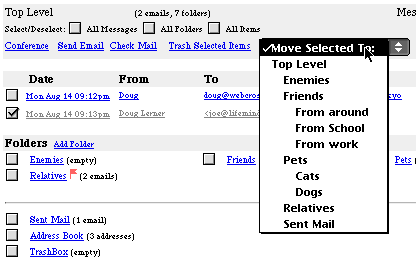
Figure
11 shows one item selected and the popup, hierarchical move
menu ready for selection. Multiple items can be moved
at the same
time. And convenient multi-selection buttons above the toolbar
let you select all messages, all personal folders or all items
at once.
Let's
take a look at Mailbox Preferences too, while we are
here.
Figure
12 - Regular User Mailbox Preferences
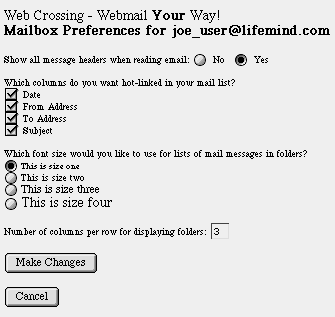
Figure
12 shows the individual preferences users can set for their
own Mailboxes. These are:
- Whether
or not to display full Internet headers in received
email.
- Which
columns to link in message lists.
- The
font size for message lists.
- The
number of columns per row for displaying personal
folders.
New
preferences are being added all the time.
In
addition to the personal preferences shown above, the sysop can
see and set additional site-wide Mailbox preferences.
Figure
13 - Site settings for Webmail (expiration)
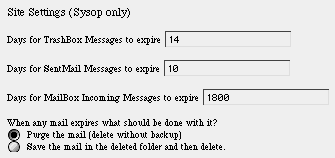
Figure
13 shows expiration settings for messages in the TrashBox,
in the Sent Mail folder and for incoming Mailbox messages. When
expiration occurs, mail can either be purged or, if the sysop
chooses, mail can be backed up in the Web Crossing
server's deleted
folder and then removed from the user's Webmail box.
(This latter
option can lead to the deleted file growing to enormous
size, so should be used with caution.)
Figure
14 - Site settings for Webmail (footers)
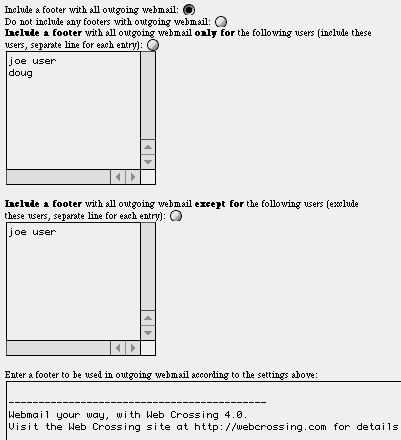
Figure
14 shows footer settings. Footers can be attached for site
promotional purposes to all outgoing Webmail. The
sysop can also
choose to only attach promo footers to certain users' Webmail.
Conversely, the sysop can choose to attach promo footers to all
users except for certain excluded users.
There
are site settings being added all the time as well.
We
want Web Crossing Webmail to be the best Webmail anywhere. We
encourage suggestions for new features and preference
settings.
Web
Crossing Webmail FAQ
This
FAQ answers frequently asked questions for your
members.
Q.
Must I use the new Webmail service?
A. Not unless you want to. If you like, you can
just ignore
it and continue using your current email client,
such as Eudora,
Outlook Express or Netscape Mail.
Q.
Do I have to choose between Webmail and POP3 mail?
A.
No. You can use both. In fact, it is often convenient to use
both. For example, suppose you use more than one
computer during
the day. You can designate one computer as your
"main" workstation
and download mail to that computer using your favorite mail
client. Yet you can still continue to check your
mail from other
computers via Webmail. Any computer running a Web
browser gives
you access to your Web Crossing email from
anywhere.
Q.
What are some benefits of Webmail?
A.
(1) The ability to check your email from any computer
with a browser - without installing special
software and without
needing to set up your mail account; (2)
Previewing your
mail - you can check to see if you have mail and
read and reply
to individual messages without downloading all your
mail; (3)
Deleting mail without downloading - you can delete unneeded
messages with big attachments without downloading
them; (4)
You can send email from anywhere, under your name,
even if the
computer you are using does not have your mail
account registered.
Q.
What are some other benefits of accessing the Web
site?
A.
(1) You can change your own mail password whenever
you want; (2) You can edit your mail
aliases (alternate
names for sending and receiving mail - if the sysop allows
users to do this); (3) You can set email forwarding
to other email addresses.
Q.
When might I not want to use Webmail?
A.
If you always use the same computer for your
email and don't
need to check mail from other computers then you might find
it convenient to just ignore Webmail and continue
using your
current POP3 mail client. If you are regularly dealing with
thousands of mail messages, you will probably find it more
convenient to download your email to your own computer and
work offline.
Web
Crossing - Webmail Your Way!
|

